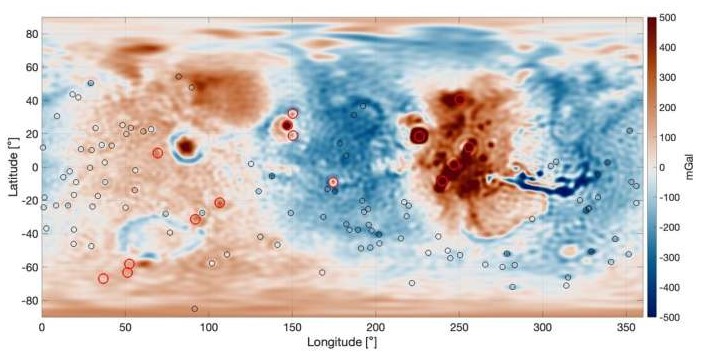Mars hides massive structures under its surface
Researchers studying Mars' gravity variations have uncovered large, dense structures hidden beneath sediment layers, believed to lie on an ancient ocean floor. Using models and data from multiple missions, they also identified active processes in the Martian mantle that may be elevating Olympus Mons, the largest volcano in the solar system.
These findings were presented at the Europlanet Science Congress (EPSC) in Berlin by Bart Root from Delft University of Technology (TU Delft), whose team worked in collaboration with colleagues at Utrecht University in the Netherlands.
More to read:
Scientists could “see” the composition of Mars’ core for the first time ever
While Mars is known for concealed features like ice deposits, the newly discovered structures in the northern polar plains remain enigmatic, buried beneath thick, smooth sediment.
"These dense formations could be volcanic or the result of ancient impacts. We’ve identified around 20 such features near the northern polar cap - one even resembles the shape of a dog.
[…]There's no visible trace at the surface, but gravity data offers us a glimpse into the older geological history of Mars' northern hemisphere," the two universities said in a press release.

Gravity map of Mars. The red circles show prominent volcanoes on Mars and the black circles show impact crates with a diameter larger than a few 100 km. A gravity high signal is located in the volcanic Tharsis Region (the red area in the centre right of the image), which is surrounded by a ring of negative gravity anomaly (shown in blue). Image: Dr. Root & team.
The scientists from TU Delft and Utrecht University, led by Dr. Root, analyzed small deviations in satellite orbits to study Mars' gravity field, providing insights into the planet's internal mass distribution. This data, combined with new observations from NASA's InSight mission on the Martian crust and mantle dynamics, enabled the team to create a global density map of the planet.
The map reveals that the northern polar features are 300–400 kilograms per cubic meter denser than their surroundings. Additionally, the study sheds light on the structures beneath the vast volcanic region of Tharsis Rise, home to Olympus Mons. Though volcanoes are typically dense, the Tharsis region sits much higher than the Martian average and is surrounded by a weak gravity zone.
More to read:
Huge deposits of ice discovered at Mars equator
This anomaly is puzzling when considering only the crust and upper mantle. Dr. Root's team suggests that a light mass, approximately 1,750 kilometers wide and 1,100 kilometers deep, may be pushing the entire region upward, likely due to a massive lava plume rising from Mars' deep interior.
"The NASA InSight mission has provided crucial data about Mars' outer layer, prompting a re-evaluation of how Olympus Mons and its surroundings are supported," said Dr. Root. "These findings indicate that Mars may still experience internal movements, possibly contributing to future volcanic activity on the surface."
***
NewsCafe is an independent outlet that cares about big issues. Our sources of income amount to ads and donations from readers. You can support us via PayPal: office[at]rudeana.com or paypal.me/newscafeeu. We promise to reward this gesture with more captivating and important topics.







